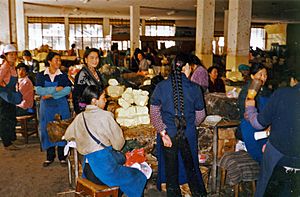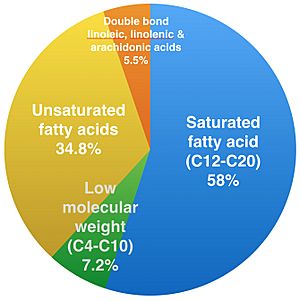Yak butter facts for kids

Yak butter (also known as "Dri Butter" or "Su oil") is a special type of butter. It is made from the milk of the domestic yak, a large, shaggy animal. Many communities in countries like China, India, Mongolia, Nepal, and Tibet produce and use dairy products from yak milk. These products include butter.
Yak milk has about twice as much fat as cow's milk. This makes yak butter have a texture that is more like cheese. It is a very important staple food and trade item for people who herd yaks in Central Asia and the Tibetan Plateau.
How Yak Butter is Made
Yaks are very helpful to their herders. They provide many things, like dung for fuel, power for pulling things, meat, fiber, and milk. Not all herding groups use yak milk or make butter. However, it is very common in mountain areas.
Each female yak (called a 'nak' or 'dri') produces only a small amount of milk. So, herders need large groups of yaks to get a lot of milk. Yaks give much more milk in summer than in winter. Turning fresh milk into butter or cheese helps store food for later use.
In western Tibet, yak milk is first left to ferment overnight. This means it sits and gets a bit sour, like yogurt. In summer, this yogurt-like mix is churned for about an hour. People use a wooden paddle in a tall wooden churn to do this. In winter, they collect yogurt for several days. Then, they pour it into a special bag made from a sheep's stomach. They shake it until the butter forms.
Fresh yak butter can be stored for up to a year. It stays good if it is not exposed to air and kept in a cool, dry place. It is often sewn into bags made from sheep stomachs. It can also be wrapped in yak skin or large rhododendron leaves. Once the container is opened, yak butter will start to change. It might get blue mold, similar to blue cheese.
What is Yak Butter Used For?

Yak butter tea is a common drink every day in the Himalaya region. It is usually made with yak butter, tea, salt, and water. These ingredients are churned together to make a frothy drink. It is known as the "Tibetan national beverage." Tibetans often drink many small cups a day. This helps them stay hydrated and get the nutrition they need in cold, high places. Sometimes, butter that has been stored for a while is used, which gives the tea a different taste.
Melted yak butter can be mixed with roasted barley flour, called tsampa. They are mixed in about equal amounts. This dough, sometimes with dates or sesame seeds, is used to welcome guests. It can also be stored and later melted into hot water with salt or sugar.
Yak butter is also used in a traditional process called tanning. Tanning turns animal skins into leather. Older, stored butter is often preferred for this over fresh butter.
Other uses for yak butter that are not food include:
- Fueling special yak-butter lamps.
- Moisturizing skin.
- Making traditional butter sculptures for the Tibetan New Year. These sculptures can be very tall, almost 10 meters high!
In Nepal, especially in Kathmandu, yak cheese and yak butter are made in factories. They are then sold in stores. For example, during 1997–1998, twenty-six tonnes of butter were made and sold this way in Nepal.
See also
 In Spanish: Manteca de yak para niños
In Spanish: Manteca de yak para niños



